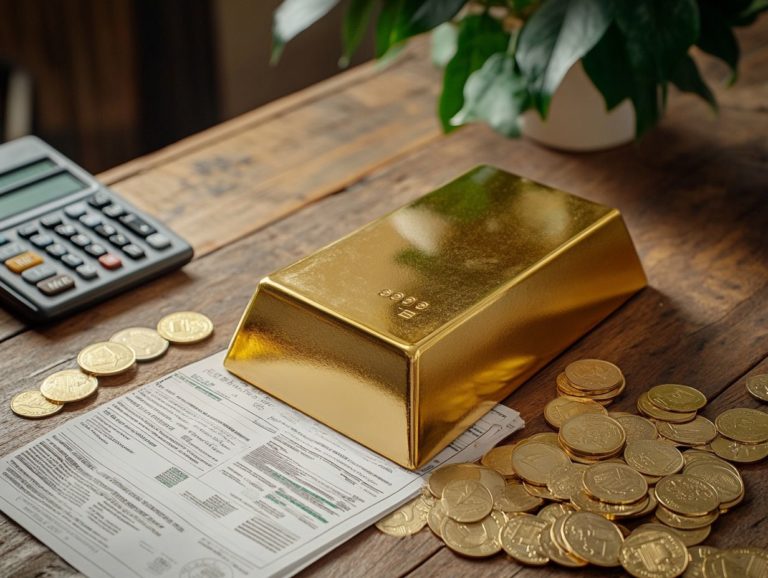How to Choose a Gold Investment Fund
Investing in gold can be a savvy strategy to diversify your portfolio and safeguard your wealth. With various options available, understanding gold investment funds is essential for making well-informed decisions.
This article explores what gold investment funds are, the different types available, and key factors to consider when choosing one. It also looks at how to assess these funds by comparing performance metrics and management styles. Ultimately, this guide helps you make your final investment choice.
Whether you’re a seasoned investor or just starting your journey, get ready to confidently navigate the world of gold investment funds with this guide!
Contents
- Key Takeaways:
- Understanding Gold Investment Funds
- Factors to Consider Before Choosing a Gold Investment Fund
- How to Evaluate and Compare Gold Investment Funds
- Making the Final Decision
- Frequently Asked Questions
- What is a gold investment fund?
- Why should I consider investing in a gold investment fund?
- How do I choose the right gold investment fund?
- Are there different types of gold investment funds?
- Can I lose money investing in a gold investment fund?
- What are the tax implications of investing in a gold investment fund?
Key Takeaways:

- Check the fund’s performance history for potential returns.
- Consider management quality and related expenses.
- Focus on diversification and seek professional advice.
Understanding Gold Investment Funds
Understanding gold investment funds is crucial for any investor looking to diversify their portfolio and protect against inflation in today’s unpredictable economy. These funds include a variety of gold assets, such as gold bullion, gold coins, ETFs (exchange-traded funds that you can buy and sell like stocks), and mutual funds.
As trends in the gold market shift, having a solid grasp of the fundamentals will help you make informed decisions that align with your financial goals and risk appetite.
What are Gold Investment Funds?
Gold investment funds are funds that pool money from many investors, allowing you to invest in gold-related assets, such as gold bullion, gold coins, or shares in gold mining companies. These funds simplify your gold investment journey, giving you exposure to gold price fluctuations without the hassle of physical storage.
Gold exchange-traded funds (ETFs) offer a highly liquid option, trading on stock exchanges like regular shares, allowing you to enter and exit your investment easily. In contrast, gold mutual funds typically focus on equities related to gold mining operations, letting you profit from the performance of gold companies while also benefiting from changes in gold prices. For a more comprehensive approach, consider how to build a gold investment portfolio. These investment structures provide a diversified way to engage with the gold market, catering to various risk appetites and investment strategies.
Types of Gold Investment Funds
There are several types of gold investment funds available, including gold exchange-traded funds (ETFs), gold mutual funds, and funds specifically focusing on gold mining companies. These options allow you to tailor your investment strategies based on your financial goals and risk tolerance.
Gold ETFs are often praised for their liquidity and ease of trading, making them an excellent choice if you prefer a more hands-on approach. On the other hand, gold mutual funds typically pool capital to invest in various gold-related securities, providing a diversified portfolio managed by professionals ideal for those seeking a more passive investment route. If you’re looking to diversify further, consider exploring how to start a silver investment fund for additional opportunities.
If you’re inclined towards direct investments, consider gold bullion or mining stocks, which offer tangible value and exposure to physical commodities or the mining sector. This approach can be particularly appealing if you believe in the long-term growth potential of the gold market. Additionally, exploring tax-free gold investments may also provide beneficial options.
Factors to Consider Before Choosing a Gold Investment Fund
Before choosing a gold investment fund, it s essential to weigh several key factors. First, examine the fund’s performance history and evaluate the quality of its management.
Also, consider the associated expenses, as well as the overall risk and diversification of your investment strategy, especially given the unpredictable nature of the gold market.
Understanding these elements will help you make informed decisions in your investment journey.
Performance and Track Record

The performance and track record of gold investment funds greatly shape your decision-making process. They offer valuable insights into how effectively the fund has navigated past market conditions and capitalized on gold price fluctuations.
By examining historical data, you can assess the fund’s ability to respond to both rising prices and falling prices. For example, during the 2008 financial crisis, many gold investment funds thrived as gold prices soared. This showcases their resilience and highlights the importance of understanding how to build a precious metals portfolio.
This historical perspective emphasizes the importance of consistent returns. Investors often favor funds that have demonstrated a proven ability to deliver steady performance across various market cycles. By analyzing past performance, you can better understand a fund’s risk profile and its alignment with your investment strategy.
Management and Expenses
Management and expenses are pivotal factors when evaluating gold investment funds. High management fees can eat into your returns. They can also undermine your investment strategies.
The expertise of fund managers is crucial for navigating the complexities of the gold market. Skilled management can identify the perfect moments for buying and selling gold, significantly influencing fund growth.
Fee structures can dramatically impact your long-term investment outcomes. Lower fees often allow more of your investment to grow over time, enhancing your overall yield. Conversely, higher fees can deter investors and limit the fund’s potential.
Risk and Diversification
Get to know the risk-reward balance it’s key to your success! Effective diversification helps you mitigate risks while still exposing you to potential gold returns, even during market volatility.
To find this balance, consider incorporating various gold assets into your portfolio. Think physical bullion, gold mining stocks, and gold exchange-traded funds (ETFs). Each has its unique risk profile and liquidity options. Additionally, you might explore the top silver investment strategies to diversify your approach. Blending these can enhance your portfolio’s stability and position you to capitalize on different market conditions.
You might also want to explore geographical diversification by investing in gold from different regions. This provides an additional hedge against local economic downturns.
Using a strategy like dollar-cost averaging can help you. This means investing a fixed amount regularly, regardless of price changes, which eases your overall risk burden.
How to Evaluate and Compare Gold Investment Funds
To effectively evaluate and compare gold investment funds, use a range of key metrics and conduct thorough research and analysis. This will help you identify the fund that best matches your investment objectives.
Key Metrics to Look at
When comparing gold investment funds, pay attention to key metrics like the fund’s expense ratio, historical performance, and volatility. These indicators are crucial for guiding your decision-making.
Understanding these metrics can significantly influence your fund selection, tailored to your individual risk tolerance and investment goals. A lower expense ratio often means better long-term returns. Historical performance offers insights into how the fund has handled market fluctuations.
Assessing volatility is equally important. It helps you evaluate the level of risk involved. Funds with higher volatility might provide opportunities for larger gains but come with a greater risk of losses. These factors affect your immediate investment choices and play a key role in a broader risk assessment strategy, ensuring your investment aligns with your overall portfolio objectives.
Research and Analysis

Conducting thorough research and analysis of gold investment funds is essential for examining market trends, fund performance, and investment strategies to determine their alignment with your financial goals.
By leveraging a variety of resources and tools such as financial news platforms, analytical software, and expert reviews you can gain a clearer understanding of how these funds operate and respond to economic fluctuations. Accessing real-time data and historical performance reports enables you to assess which funds match your risk tolerance and investment timelines.
Engaging in online forums or consulting financial advisors can provide invaluable insights, helping you navigate the complexities of the gold market. To further safeguard your assets, understanding how to protect your gold investments is essential. Ultimately, a comprehensive grasp of these elements is crucial for making informed and confident investment decisions.
Making the Final Decision
In terms of making the final decision about gold investment funds, it’s essential for you to carefully consider your personal investment goals, your risk tolerance, and the potential returns that various types of funds can offer.
Taking the time to evaluate these factors will ensure that your investment aligns with your financial aspirations.
Factors to Prioritize
When selecting a gold investment fund, prioritize factors that align with your specific investment goals and risk tolerance to ensure you achieve optimal returns. Understanding your risk tolerance is essential as different funds expose you to varying levels of gold price fluctuations.
For example, a fund focused mainly on gold mining stocks may present higher volatility and risk compared to one that simply tracks the gold price.
It’s also important to set realistic return expectations. While some funds might promise sky-high returns, they often come with considerable risks. The quality of fund management is also crucial; seasoned managers are adept at navigating market changes and making informed investment decisions, significantly impacting the fund’s overall success. To enhance your understanding of investments, consider learning how to educate yourself about silver investing.
By considering these factors, you can make informed decisions that align with your financial objectives. By keeping these factors in mind, you’ll be ready to seize golden opportunities!
Seeking Professional Advice
Seeking professional advice can be invaluable when navigating the complexities of gold investment funds. Experienced investment advisers offer tailored guidance and insights, enabling you to make informed decisions.
They possess a wealth of knowledge about market trends and can guide you in finding the perfect funds that match your goals. By leveraging their expertise, you gain a clearer understanding of the risks and rewards associated with various gold investment opportunities.
These professionals can assist you in developing strategies that enhance investment diversity while adapting to changing market conditions. This ensures you are well-prepared to maximize your investments in the ever-evolving landscape of gold markets.
Frequently Asked Questions
What is a gold investment fund?

A gold investment fund is a type of mutual fund or exchange-traded fund that invests primarily in gold or gold-related assets. These funds allow investors to gain exposure to the precious metal without physically owning it.
Why should I consider investing in a gold investment fund?
Gold is often seen as a hedge against inflation and a safe haven during times of economic uncertainty. Investing in a gold fund can diversify your portfolio and potentially provide a stable return on investment.
How do I choose the right gold investment fund?
When choosing a gold investment fund, consider factors such as the fund’s performance, fees, and the company managing the fund. It is also important to research the fund’s investment strategy and ensure it aligns with your investment goals.
Are there different types of gold investment funds?
Yes, there are different types of gold investment funds, such as physically-backed funds, mining company funds, and leveraged funds. Each type of fund carries its own risks and potential returns, so it is important to research and understand the differences before investing.
Start your journey to gold investment today!
Can I lose money investing in a gold investment fund?
Investing always carries the risk of losing money. Gold investment funds can fluctuate in value and may not perform as anticipated.
What are the tax implications of investing in a gold investment fund?
Tax implications can differ based on the type of gold fund and your individual tax situation. Consulting with a tax professional can provide personalized guidance.















